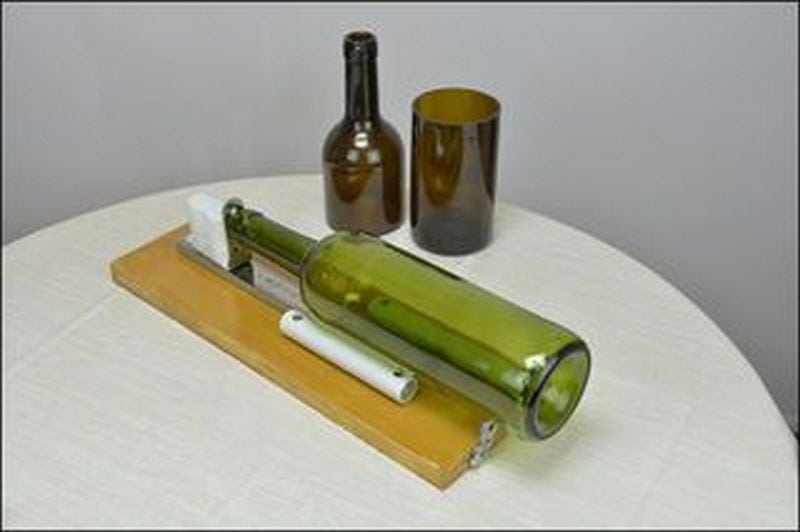
Breathe new life into old glass bottles and turn them into cute, artsy pieces for the house by building a glass bottle cutter.
Shopping for the house is a whole lot of fun until you realize how much you’ve spent. We’re all guilty of this when it comes to buying. We see something and think we “need” it so we impulsively make the purchase. But later on, we figure out we could have saved more if we recycled.
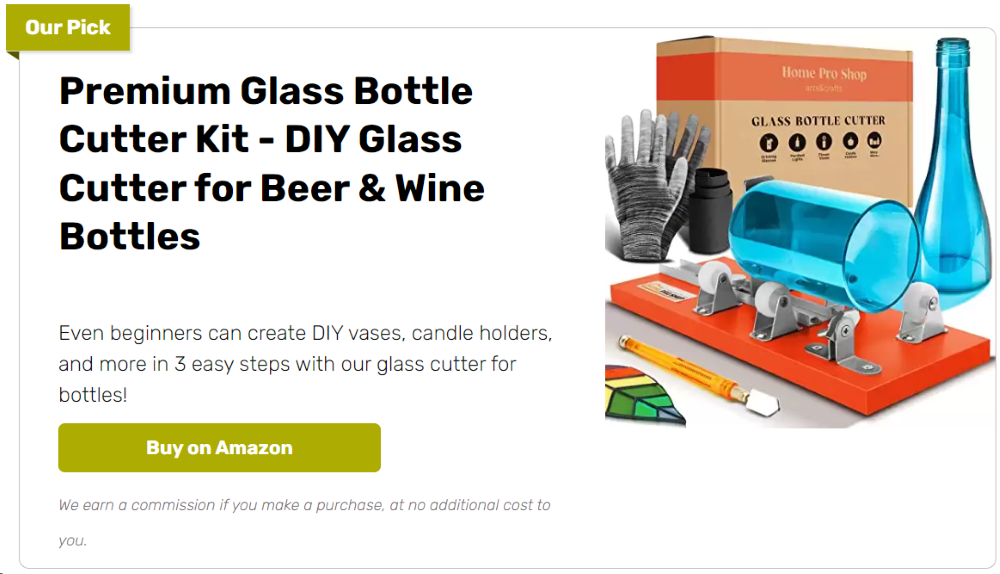
This DIY glass bottle cutter can turn empty wine bottles into excellent household pieces. You can recycle glass bottles and jars and create functional art at the same time! You can create your own glass ornaments, vases, cups, terrariums, and light fittings. The possibilities are limited only by your imagination!
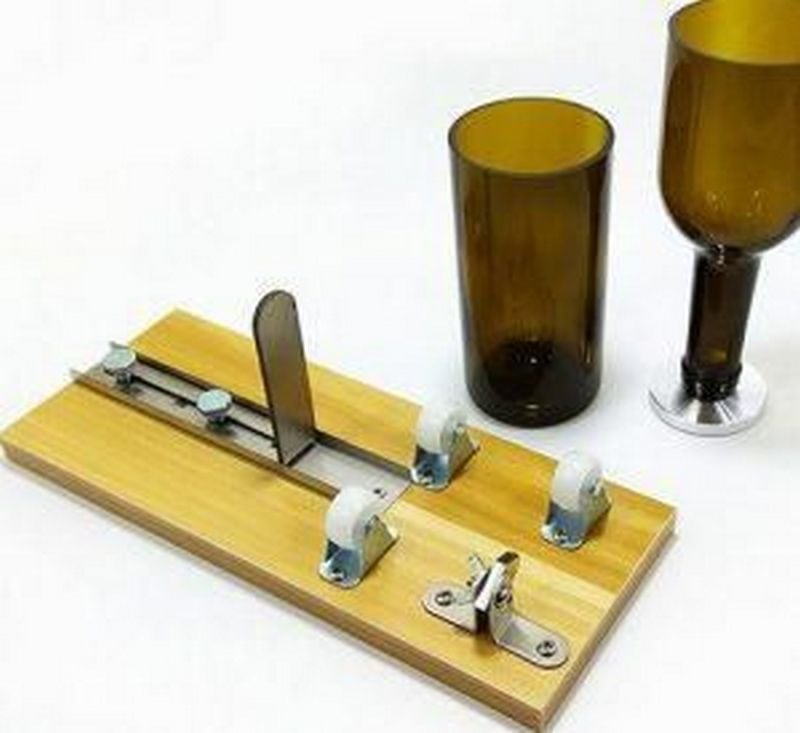
Don’t just throw your old wine bottles away. With your very own glass bottle cutter, you can go as artsy as you want. Gather the things that you need and start making yours today!
Contents
Making a Glass Bottle Cutter
Materials
- A piece of wood
- Plastic pipe
- Glass cutter
- A piece of steel
- “L” shape bracket
- Neodymium magnets
- Furniture sliders or a piece of felt
- Epoxy glue
- Screws
Tools
- Pipe Cutter
- Steel ruler
- Drill with drill bits
- Sandpaper (optional)
- Mini saw
Instructions
Step 1: Prepare the Base
- Cut the Wood: Use the mini saw to cut the piece of wood into a base for your cutter. A recommended size is about 12 inches long and 6 inches wide.
- Sand the Edges: If the edges are rough, use sandpaper to smooth them out to prevent splinters.
Step 2: Mount the Steel Arm
- Cut the Steel: Measure and cut a piece of steel about 8 inches long with the mini saw.
- Attach the “L” Bracket: Screw the “L” bracket to one end of the steel piece. This will hold the glass cutter.
- Mount the Arm to the Base: Center and mount the steel arm to the base using screws. Ensure it is firmly attached and can withstand pressure.
Step 3: Attach the Glass Cutter
- Position the Glass Cutter: Attach the glass cutter to the “L” bracket so that its cutting wheel just overhangs the edge of the bracket.
- Secure with Epoxy Glue: Use epoxy glue to secure the glass cutter in place, ensuring it is aligned and stable.
Step 4: Create the Rotation Track
- Measure and Cut the Plastic Pipe: Use the pipe cutter to cut a length of plastic pipe slightly longer than the width of your base.
- Attach Pipe to Base: Position the pipe parallel to the steel arm and secure it to the base with screws. This will act as the track for the bottle to rotate.
Step 5: Install Magnets and Sliders
- Attach Neodymium Magnets: Place magnets on the base near the pipe. These will help to hold the bottle firmly in place during cutting.
- Fix Furniture Sliders or Felt: Attach furniture sliders or felt pieces under the base to prevent scratching your work surface.
Step 6: Assembly and Testing
- Assemble Your Cutter: Ensure all parts are securely attached and the glass cutter is aligned correctly to cut at the desired height of the bottle.
- Test with an Old Bottle: Place a bottle on the pipe and gently rotate it against the cutter to score the glass. Adjust the cutter as necessary.
Step 7: Final Adjustments
- Fine-Tuning: Make any adjustments to ensure the cutter scores consistently around the bottle.
- Additional Sanding: Optionally, sand any additional rough edges or surfaces for a smoother finish.
Click on any image to start the lightbox display. Use your Esc key to close the lightbox.
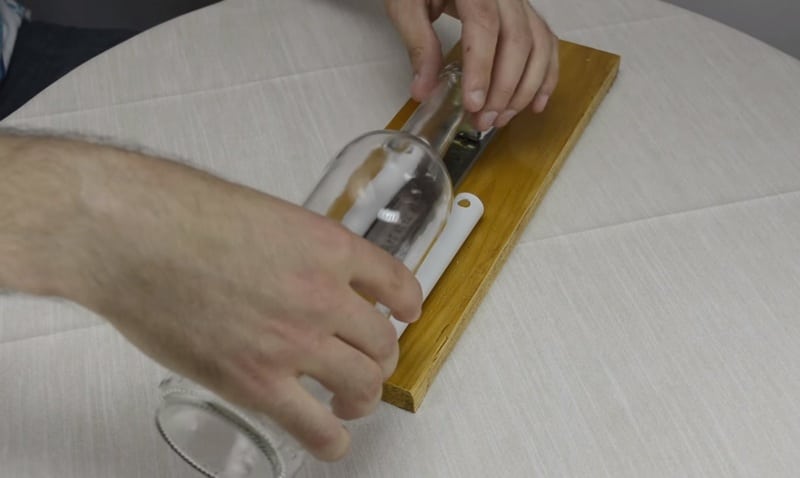
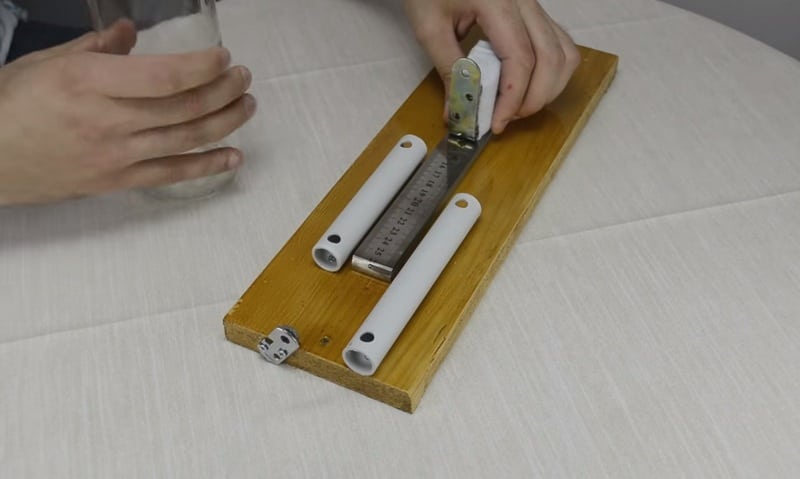



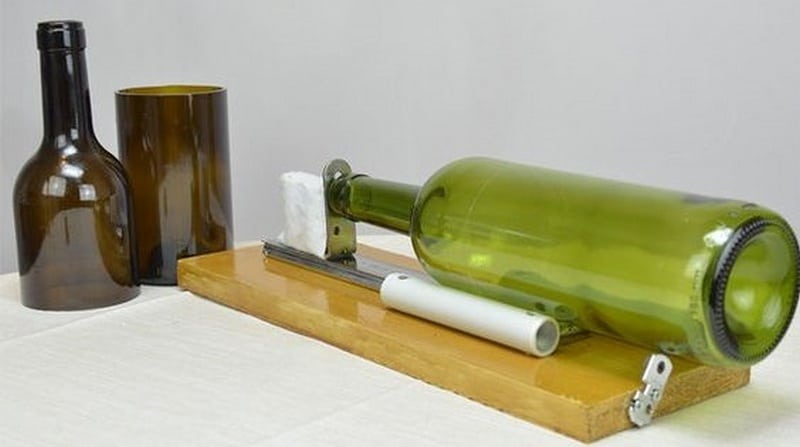
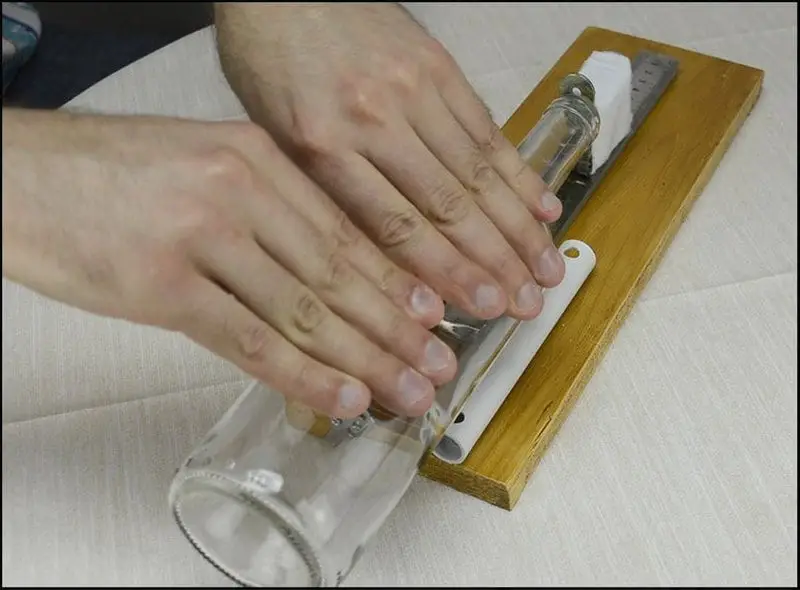
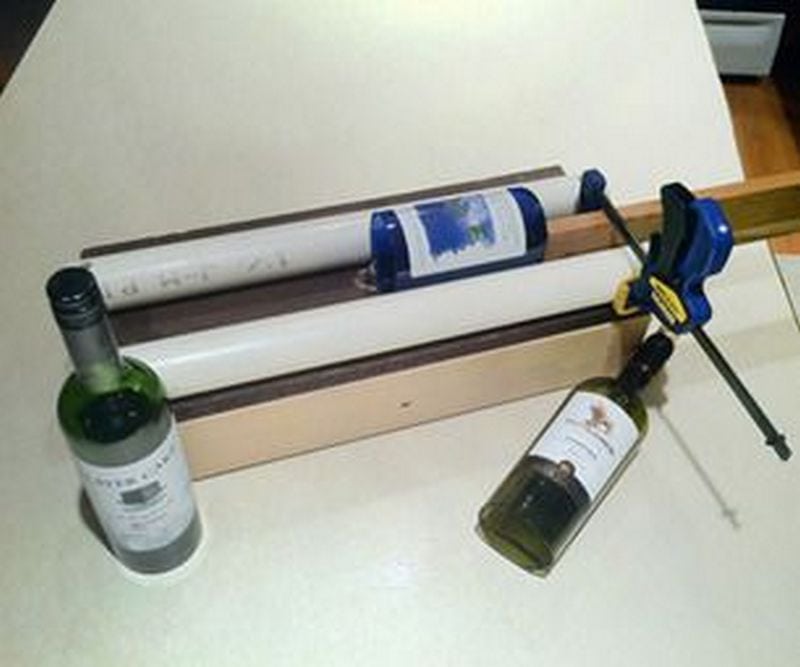

For a visual guide, check out the video below.
Safety Tips for Handling Glass
When using a glass bottle cutter, safety should always be your top priority. Glass can easily break and cause injuries, so it’s essential to take precautions to protect yourself and those around you.
Here are essential safety tips to keep in mind while using your DIY glass bottle cutter.
Wear Protective Gear
Always wear safety glasses to shield your eyes from flying glass shards, which can be particularly dangerous. Durable gloves should also be worn to protect your hands not only from cuts but also from potential sharp edges of the glass after cutting.
Work in a Suitable Environment
Ensure that the area where you are using the DIY bottle cutter is well-lit and free of any unnecessary clutter that might cause accidents. A stable, flat surface is crucial for safely scoring and cutting glass bottles. Make sure the floor around you is clear of glass debris to prevent slips and falls.
Handle with Care
When using a glass bottle cutter, handle the glass gently. Apply a consistent pressure when scoring the glass to create a neat cut; excessive force can cause the bottle to crack unpredictably. After cutting, the edges of the glass can be extremely sharp, so handle the cut sections with care and always keep them away from children and pets.
Proper Disposal of Glass Waste
After using your glass bottle cutter, there might be leftover glass scraps or failed projects. Dispose of these glass pieces safely by wrapping them in newspaper or placing them in a cardboard box before disposal. This helps prevent injury to sanitation workers and anyone else who might handle your trash.
Emergency Preparedness
Keep a first aid kit nearby when working with your glass bottle cutter. In case of an accident, having easy access to bandages and disinfectants can help manage any minor injuries immediately.
You may enjoy using your glass bottle cutter with the lowest possible danger of damage by according to these safety advice. Beautiful, recycled glass crafts should be safe and enjoyable to make.
Troubleshooting Common Issues with Glass Bottle Cutters
Using a glass bottle cutter can be a creative and rewarding experience, but sometimes you may encounter issues that affect the quality of your cuts.
Here are some common problems you might face while using a glass bottle cutter and practical solutions to resolve them.
Uneven Cuts
If you notice that the cuts made by your glass bottle cutter are uneven, there are a few potential causes:
- Check the Cutter Wheel: Ensure that the cutting wheel is not worn out or damaged. A dull or damaged wheel can make uneven cuts.
- Stabilize the Bottle: Make sure the bottle is securely placed and doesn’t move during the cutting process. Any movement can result in an uneven score line.
Incomplete Score Lines
An incomplete score line can prevent the glass from breaking cleanly. To fix this:
- Adjust the Pressure: Apply consistent pressure while scoring. Too much or too little pressure can result in an incomplete cut.
- Repeat the Score Line: If the first score line is incomplete, carefully go over the line one more time with the glass bottle cutter without exerting excessive force.
Glass Cracking During Cutting
Cracking is a common issue when the glass is stressed improperly:
- Heat Gradually: After scoring, if you’re using heat to separate the glass, ensure it’s applied gradually. Sudden changes in temperature can cause the glass to crack.
- Even Scoring: Ensure the score line is even all around the bottle. An uneven score can lead to stress points that cause unwanted cracking.
Difficulty in Getting Clean Breaks
Sometimes, despite a perfect score line, the bottle might not break off cleanly:
- Tap Gently: After scoring with the glass bottle cutter, gently tap along the score line with a tool that can distribute a light, even force (like a rubber mallet). This can help initiate a cleaner break.
- Use Hot and Cold Water: Alternating hot and cold water along the score line can also help achieve a cleaner break. Pour hot water first, followed by cold water.
With these typical problems fixed, your glass bottle cutter will cut more smoothly and cleanly and increase your success rate. To guarantee that your do-it-yourself projects work out nicely, always take your time to prepare and treat every stage with care.
Design Ideas and Inspiration Using a Glass Bottle Cutter
Unlocking your creativity with a glass bottle cutter can transform ordinary glass bottles into stunning, functional art pieces for your home or as gifts.
Here are some inspiring ideas to get you started on your next project, showcasing the versatility and potential of upcycled glass.
Create Custom Vases
Turn old wine or liquor bottles into unique, stylish vases. You can cut the bottles at various heights to create a set of matching vases for a floral display. Enhance their appearance by painting them or wrapping them with twine or lace for a rustic look.
Decorative Candle Holders
Using your glass bottle cutter, you can make exquisite candle holders. Cut the bottom part of wine bottles and smooth the edges to create protective covers for candles. These can be great for both indoor ambiance and outdoor wind protection for candles.
DIY Drinking Glasses
Cut the tops off of sturdy bottles to make original, eco-friendly drinking glasses. Sand the edges thoroughly to ensure they are smooth and safe to use. You can further personalize them by etching designs or adding colorful rims.
Hanging Light Fixtures
Transform clear or colored glass bottles into beautiful hanging light fixtures. Cut the bottom of the bottles and insert light bulbs or LED lights inside. These pendants can add a warm, industrial touch to your kitchen or dining area.
Build a Glass Bottle Wall
For a more ambitious project, use your glass bottle cutter to cut numerous bottles, and then assemble them using a suitable adhesive to create a decorative glass bottle wall. This can serve as a stunning feature wall in your garden or patio.
Terrariums for Small Plants
Create miniature terrariums by cutting large bottles in half and filling them with soil, rocks, and small plants. These make for delightful windowsill or tabletop displays, bringing a bit of greenery into your space.
These design ideas are just the beginning of what you can achieve with a glass bottle cutter. Each project not only adds beauty and utility to your home but also promotes sustainability through upcycling. Start with these ideas, and let your creativity flow to explore even more possibilities.
Conclusion
Making your own glass bottle cutter is a fun do-it-yourself hobby that lets you turn used bottles into beautiful and useful objects. You can make many different kinds of useful things and original home décor with the correct equipment and a little imagination. Through upcycling, this project not only improves your making abilities but also promotes environmental sustainability.
FAQ: Glass Bottle Cutter
- What factors should be considered when choosing a bottle cutter for ease of use and efficiency?
- When selecting a bottle cutter, prioritize precision, durability, versatility, and user experience for the best results. Look for a cutter that creates accurate, continuous score lines and allows flexibility to score at any point, even near the bottom edge.
- Choose durable equipment with cutting wheels made of high-quality materials like Tungsten Carbide, ensuring a long blade lifespan and compatibility with various bottle shapes, including tapered designs. Finally, balance cost and functionality, keeping in mind that even with a quality cutter, achieving a perfect bottle break may require additional care and technique.
- What bottle cutter is recommended for larger bottles or specific bottle shapes?
- If you plan to cut larger bottles, such as whiskey bottles, choose a bottle cutter specifically designed for bigger sizes and unique shapes. Look for adjustable cutters that can handle various bottle dimensions and offer sturdy, high-quality construction for stability and control. Select tools with cutting wheels designed for thick glass to ensure clean, accurate cuts while minimizing jagged edges.
- What are some challenges users face with specific bottle cutters, such as cutting at the neck or base of a bottle?
- Bottle cutting, while creative and rewarding, presents challenges, particularly when working on bottle necks or bases. Precision is crucial on curved or tapered surfaces, but varying glass thickness, especially at the neck or base, can complicate cuts and increase the risk of cracking.
- Many tools lack the design to handle tight curves or irregular shapes effectively, while improper stabilization during cutting can pose safety risks. To overcome these challenges, choose adjustable cutters like those from Inland Craft or Ephrem’s Original, practice on spare bottles to refine your technique, and always use safety gear such as gloves and goggles to ensure a secure and successful crafting experience.
- How does the thickness and type of glass affect the bottle cutting process?
- The thickness and type of glass significantly impact the bottle-cutting process, influencing how the glass responds to scoring and breaking. Glass thickness varies, with bases often thicker than necks. In thicker sections, more force is required for a clean break while delicacy is demanded in thinner areas.
- The type of glass matters too—tempered glass is designed to shatter rather than crack, making it unsuitable for cutting, unlike regular soda-lime glass, which is more predictable. A steady scoring process, careful heat application, and even pressure around the bottle’s circumference are essential for avoiding irregular cracks and achieving clean, precise cuts tailored to the glass’s characteristics.
- What techniques or tools are recommended for cutting square or larger diameter bottles?
- Cutting square or larger diameter bottles requires precision and the right tools. Focus on decoupling scoring from breaking, ensuring the scoring process is precise with no gaps or overlaps, especially near thicker sections like the base.
- Use high-quality cutters with durable cutting wheels (Silicon Carbide, Tungsten Carbide, or Steel) and versatile designs to handle various shapes and tapered bottles, while also inspecting the score line under magnification for uniformity. Manage the breaking process carefully with appropriate heating and cooling methods to prevent cracks, and select user-friendly tools that balance cost, durability, and adaptability for different bottle shapes.
- What are the limitations of a bottle cutter when it comes to cutting different bottle shapes?
- Bottle cutters face limitations when working with diverse bottle shapes due to glass thickness variations and shape irregularities. Thicker bases and uneven walls, especially in round bottles, can lead to inconsistent breaks without precise control. Square, oval, and tapered bottles present additional challenges, such as difficulties scoring around corners or achieving straight lines on tapered surfaces, as standard cutters are designed for flat or cylindrical surfaces.
- To overcome these issues, separate the scoring and breaking processes, use specialized heating or pressure techniques, and select tools designed to accommodate non-standard shapes for more consistent results.
- What are users’ experiences with various bottle cutters in terms of ease of use and success rate?
- User experiences with bottle cutters often highlight a mix of excitement and initial challenges, particularly for beginners. Many novices encounter frustration when bottles fail to separate cleanly, even when using traditional heating and cooling methods. However, patience and a methodical approach, such as gradually alternating heat and cold, often lead to cleaner cuts and improved success rates over time.
- Users report significant improvements with practice and the right tools for precise scoring and adjustments, achieving consistently smooth cuts and transforming bottles into beautiful decorative pieces.
- What are the criteria for evaluating bottle cutters?
- When evaluating bottle cutters, prioritize factors that ensure precision, durability, and versatility. Look for tools that provide straight, well-aligned score lines with placement flexibility, allowing scoring even near the base of bottles.
- Opt for cutters with durable wheels made from materials like Silicon Carbide or Tungsten Carbide and check their lifespan to ensure cost-effectiveness. Ensure the cutter can handle various bottle shapes, including tapered designs, and is user-friendly, easy to assemble, and compatible with different bottle sizes. Meeting these criteria enhances your chances of achieving clean, continuous cuts and successful project results.
- How do changes in product design, like more pliable separating rings, affect the usability of a bottle cutter?
- Design improvements in bottle cutters, such as more pliable separating rings, have significantly enhanced usability for DIY crafters. The increased flexibility of these rings allows for easier installation, letting users roll them smoothly down the bottle instead of struggling to stretch them over the neck.
- With a softer durometer measurement of 35A, the rings require less effort to apply, reducing frustration and saving time. Additionally, their snugger fit improves alignment, contributing to cleaner and more precise cuts, demonstrating how small design refinements can greatly enhance the crafting experience.
- What is the impact of a bottle cutter’s ability to cut tapered bottles?
- The ability of a bottle cutter to handle tapered bottles significantly affects both the precision and aesthetics of the final cut. Many wine bottles, for example, have subtle to moderate tapers. When using a bottle cutter that doesn’t accommodate tapering, such as those with flat rollers, achieving a straight score is challenging. As the bottle rotates, the cutter naturally tends to spiral, leading to uneven cuts.
We have more ways for you to repurpose wine bottles. Check out our decorative bottle lanterns next!





